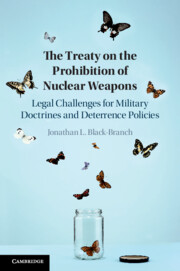 The Treaty on the Prohibition of Nuclear Weapons
The Treaty on the Prohibition of Nuclear Weapons Published online by Cambridge University Press: 17 April 2021
The success of any arms control treaty generally depends on its ability to achieve its primary objectives and intended outcomes. At the heart of measuring such success are effective compliance criteria and verification mechanisms. This includes the ability to apply metrics to assess tangible outcomes and measurable outputs and benchmarks of achievement, including on-site visits. In relation to nuclear issues, this also means that verification of both the non-diversion of nuclear material from declared peaceful activities (i.e., correctness of conduct), and the absence of undeclared or clandestine nuclear activities in a particular state (i.e., completeness in following treaty terms).
To save this book to your Kindle, first ensure [email protected] is added to your Approved Personal Document E-mail List under your Personal Document Settings on the Manage Your Content and Devices page of your Amazon account. Then enter the ‘name’ part of your Kindle email address below. Find out more about saving to your Kindle.
Note you can select to save to either the @free.kindle.com or @kindle.com variations. ‘@free.kindle.com’ emails are free but can only be saved to your device when it is connected to wi-fi. ‘@kindle.com’ emails can be delivered even when you are not connected to wi-fi, but note that service fees apply.
Find out more about the Kindle Personal Document Service.
To save content items to your account, please confirm that you agree to abide by our usage policies. If this is the first time you use this feature, you will be asked to authorise Cambridge Core to connect with your account. Find out more about saving content to Dropbox.
To save content items to your account, please confirm that you agree to abide by our usage policies. If this is the first time you use this feature, you will be asked to authorise Cambridge Core to connect with your account. Find out more about saving content to Google Drive.